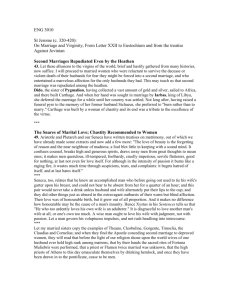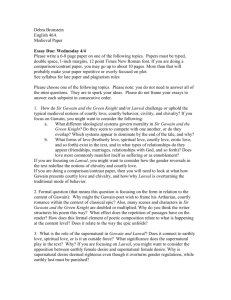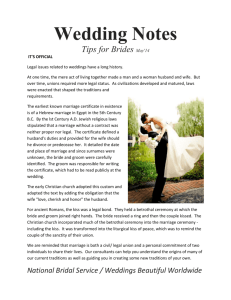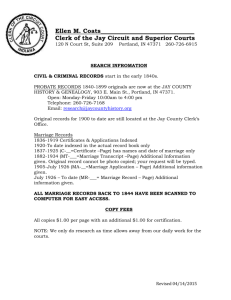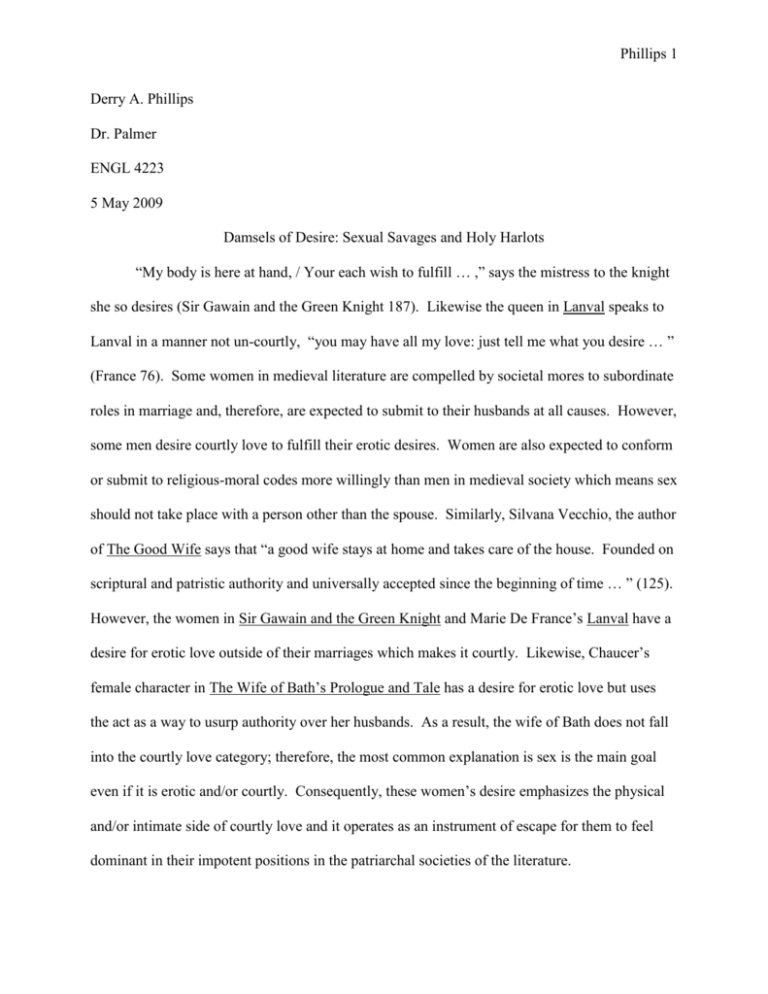
Phillips 1
Derry A. Phillips
Dr. Palmer
ENGL 4223
5 May 2009
Damsels of Desire: Sexual Savages and Holy Harlots
“My body is here at hand, / Your each wish to fulfill … ,” says the mistress to the knight
she so desires (Sir Gawain and the Green Knight 187). Likewise the queen in Lanval speaks to
Lanval in a manner not un-courtly, “you may have all my love: just tell me what you desire … ”
(France 76). Some women in medieval literature are compelled by societal mores to subordinate
roles in marriage and, therefore, are expected to submit to their husbands at all causes. However,
some men desire courtly love to fulfill their erotic desires. Women are also expected to conform
or submit to religious-moral codes more willingly than men in medieval society which means sex
should not take place with a person other than the spouse. Similarly, Silvana Vecchio, the author
of The Good Wife says that “a good wife stays at home and takes care of the house. Founded on
scriptural and patristic authority and universally accepted since the beginning of time … ” (125).
However, the women in Sir Gawain and the Green Knight and Marie De France’s Lanval have a
desire for erotic love outside of their marriages which makes it courtly. Likewise, Chaucer’s
female character in The Wife of Bath’s Prologue and Tale has a desire for erotic love but uses
the act as a way to usurp authority over her husbands. As a result, the wife of Bath does not fall
into the courtly love category; therefore, the most common explanation is sex is the main goal
even if it is erotic and/or courtly. Consequently, these women’s desire emphasizes the physical
and/or intimate side of courtly love and it operates as an instrument of escape for them to feel
dominant in their impotent positions in the patriarchal societies of the literature.
Phillips 2
Even though the women sexualize themselves to obtain a sense of domination, most of
them are not always successful. What is telling, and worth further exploration, is that these
medieval females display an overwhelming lustful and intense erotic desire that seemingly
supersedes marriage vows and the strict religious-moral codes of their culture. Often these
women sexually objectify themselves and seem weaker when their proffers are rejected and,
consequently, erotic desire remains. The female characters in Sir Gawain and the Green Knight,
Marie de France’s Lanval and Geoffrey Chaucer’s The Wife of Bath’s Prologue and Tale are
prime examples of this notion of sexual longing. Clearly, their erotic desire compels them to
traverse the moral and religious boundaries of their society. However, the types of love that are
desire a different amongst the three: the wife of Bath desires erotic love and the other two
women are victims and/or savages seeking courtly love. Either way it goes, they all desire to
have sex.
During the medieval period, “marriage was acknowledged to be the sole context for
legitimate sexual relations, it is in treaties on marriage where one encounters accounts of the
requirements for proper sexual behaviour” (Payer 62). Vecchio also asserts that married couples
exercised conjugal chastity, which meant, “keeping sexual activity within the limits of the
marriage doctrine … The reciprocal possession of bodies implied … absolute mutual fidelity …
Custody of a woman’s body was no longer for God’s benefit—but for her husband’s” (115).
Sexual activity is for those individuals that decided to be committed to each other in holy
matrimony, which was considered a sacrament (Vecchio 114). In stark contrast, two of the
female characters in the medieval texts above are incontinent with their concupiscence for sex
and/or courtly love with men who are lower in social status than their husbands. Although these
women were indeed expected to engage in sexual activities, it should have—according to
Phillips 3
Works Cited
Chaucer, Geoffrey. “The Wife of Bath’s Prologue and Tale.” The Norton Anthology of English
Literature. 8th Ed. Ed. Stephen Greenblatt. New York: W. W. Norton & Co., 2006.
256-284.
Cox, Catherine. “Holy Erotica and the Virgin Word: Promiscuous Glossing InThe Wife of Bath’s
Prologue.” Exemplaria 5.1 (Mar. 1993): 1-23. Literature Resource Center. Web. 21
Apr. 2009.
Karras, Ruth Mazo. “Holy Harlots: Prostitute Saints in Medieval Legend.” Journal of the
History Of Sexuality 1.1 (Jul. 1990): 3-32. JSTOR. Web. 1 May 2009.
Marie De France. The Lais of Marie De France: Lanval. 2nd Ed. Eds. Glyn S. Burgess and Keith
Busby. New York: PenguinBooks, 2003. 73-81.
Phillips 4
Annotated Bibliographies
Karras, Ruth Mazo. “Holy Harlots: Prostitute Saints in Medieval Legend.” Journal of the
History Of Sexuality Vol. 1, no. 1 (Jul. 1990): 3-32. JSTOR. Web. 1 May 2009.
This criticism explains the normal behavior of sanctified prostitutes in medieval legend.
Karras discusses that prostitution was customary in the period. However, this essay also reveals
that the women in the Medieval Legend did not do these acts for only money. This essay further
explains the sexual desire of the women in the period as well. It focuses on the married women
that believed in Christianity. Then Karras argues that this behavior in men is customary which
becomes contradictory in a sense that prostitution is not deviant.
I will use this essay to support my argument that sexual desire was prevalent in the period
and, therefore, women were obsessed with erotic love. I will take the excerpt from Mary the
Egyptian in this essay to show the similarities to the scene in Lanval. I will then use that scene
to further prove that sexual desire is wanted more than money in women.
Phillips 5
Payer, Pierre. The Bridling of Desire: Views of Sex in the Later Middle Ages. Toronto:
University of Toronto Press Incorporated, 1993
This book is about the religious approaches regarding sex and marriage. The most
important topics that apply to my research that the author discusses are gender differences,
pleasure, lust and the transmission of original sin, good marriages, continence and chastity. The
author begins with the initial sin of Adam and Eve and further explains the reproduction system
through intercourse. Then he discusses pleasure as being a sin and talks about women as being
property to their husbands and not used for sexual pleasure. The most influential chapter is
chapter three about marriage and sex. Payer gives a detail outline of the intentions for sex that
was customary in medieval society which totally has waned over the centuries. The intentions
for sex are “(1) to have children, (2) to pay the marriage debt, (3) to avoid fornication, (4) to
satisfy lust or for the sake of pleasure” (62).
I will use this book to apply each one of Payer’s intentions of sex to the literatures
discussed in my essay. As applied to the four intentions of sex, I will also the intentions as
model for sex in marriage. I will use this book to formulate my own intention of sex that Payer
would probably consider an immoral intention like two of his own as a reflection of the three
literatures discussed. I will use these intentions to agree with the author, but the activities of the
literature do not conform to his intentions which will allow me to have a good argument. I will
also use this book to attest the differences between men and women in regards to religious
expectations in a marriage.
Phillips 6
Vecchio, Silvana. “The Good Wife.” A History of Women In the West II. Silence of the Middle
Ages Ed. Duby, Georges and Perrot, Michelle. Cambridge: The Belknap Press of
Harvard University, 1994. 114-150.
In this essay, Silvana Vecchio discusses the characteristics of an ideal wife during
medieval culture or what the men viewed as a well-behaved spouse. He refers to scripture as a
modeled construct to form the perfect woman in which the men of the time thought were
acceptable in a marriage. In addition to the patriarchal influences of the marriage, mothers also
acquiesce to this notion of the woman being obedient to her husband. Vecchio begins his essay
with Abrham’s wife, Sarah, in the Bible. He discusses how devoted Sarah is to her husband and
how she submits to him without objection.
I will use this book to discuss what was expected of the women in the Middle Ages to
show how inconsistent they were in the literature. I will also use this book as a reference of
morals that people in the Middle Ages valued. Then I will show how the women in the texts
went against the morals by their actions. I will use this book to discuss that these guidelines
were not so expected of the men because it said nothing about the expectations of the man in the
marriage. So this was helpful for me to apply to the literature because the women in the
literatures discussed did not conform to the expectations in regards to sex. The wife of Bath was
the only on that satirically conformed. However, she still did not seem to be the kind of wife
discussed in Veechio’s essay.
Phillips 7
Payer, Pierre. The Bridling of Desire: Views of Sex in the Later Middle Ages. Toronto:
University of Toronto Press Incorporated, 1993
This book is about the religious approaches regarding sex and marriage. The most
important topics that apply to my research that the author discusses are gender differences,
pleasure, lust and the transmission of original sin, good marriages, continence and chastity. The
author begins with the initial sin of Adam and Eve and further explains the reproduction system
through intercourse. Then he discusses pleasure as being a sin and talks about women as being
property to their husbands and not used for sexual pleasure. The most influential chapter is
chapter three about marriage and sex. Payer gives a detail outline of the intentions for sex that
was customary in medieval society which totally has waned over the centuries. The intentions
for sex are “(1) to have children, (2) to pay the marriage debt, (3) to avoid fornication, (4) to
satisfy lust or for the sake of pleasure” (62).
I will use this book to apply each one of Payer’s intentions of sex to the literatures
discussed in my essay. As applied to the four intentions of sex, I will also the intentions as
model for sex in marriage. I will use this book to formulate my own intention of sex that Payer
would probably consider an immoral intention like two of his own as a reflection of the three
literatures discussed. I will use these intentions to agree with the author, but the activities of the
literature do not conform to his intentions which will allow me to have a good argument. I will
also use this book to attest the differences between men and women in regards to religious
expectations in a marriage.

